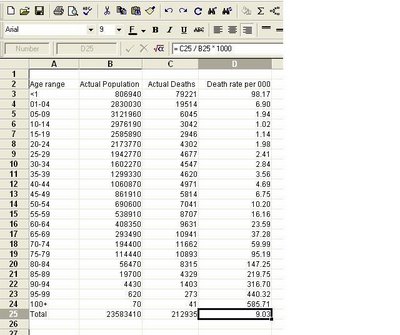On those Iraqi death rates ...
Okay, nowt to do with Channel 4, but just a bit of number-crunching. What was the death rate in Iraq before the 2003 war? The newly-released Lancet study produces a figure of 5.5/1000. To support this figure, the report's writers cite the CIA World Factbook. This is despite the fact that the CIA's figures for more recent years remain at around the same level, which, if true, would mean that virtually no excess deaths have resulted from the war.
Jon Pederson, whom the Lancet report praises, disputes the 5.5 figure here, citing a higher UNICEF figure.
Other UN bodies seem to concur. For instance, the WHO has figures for 2000-1 here. (Hat tip: A2) If you scroll down to 'Iraq', select '2001', and press 'Go!", then you'll bring up a table of death rates separated by age (irritatingly, this doesn't have a separate URL of its own):

The first three columns are the only ones you need to look at. The third column, 'nMx', is the second divided by the first, so it's the death rate for each age group.
I put this into a spreadsheet, added together the actual populations and the actual deaths, and got this:

As you can see, the WHO's overall death rate for Iraq in 2001 is 9.03/1000. But this, again, is quite a lot over the 5.5/1000 figure (for the following year) produced by the Lancet study.
And not surprisingly. Over one third of the 2001 deaths were of infants under 1 year old, and we are often told that children were bearing the brunt of the sanctions. The Lancet study says so itself, in Appendix E of its companion document. Here's a graph you can find there:

Now, it's true that the year axis doesn't go beyond 1998; but the mortality rate lines seem to do so. And nothing in what the rest of the Appendix says would lead you to believe that things had changed much for the better after 1998.
In the comments section to this post at Harry's Place, Tim has some thoughts on the strange implications of this:
if a 10% infant mortality rate applied in Iraq (A country of 25 million with 35 births per thousand) This would give a total of 85,000 deaths.
The Lancet Report claims a 5.5 crude death rate.
A total of 137,500 deaths.
If 85000 of those are under one year olds then the rest of the populataion had a crude death rate of 2.1%.
the lowest in the entire world ( by a factor of two)
And the UN's World Population Prospects study gives a rate for Iraq in 2000-2005 of 9.7/1000, and 10/1000 for the previous five years. (Hat tip: dd)
This WHO report, using the 2004 Iraq Living Conditions survey, gives a 2002 crude death rate figure of 7.8/1000.
If the point of all this needs to be spelled out, then here goes: if the pre-war figure was higher than 5.5/1000 - as all these UN figures seem to suggest - then the excess deaths must be lower.
Update: By the way, the 2004 Lancet study had an even lower pre-war crude mortality estimate, of 5/1000. Fred Kaplan criticised this figure at the time. You can read more debate about the figure here.
